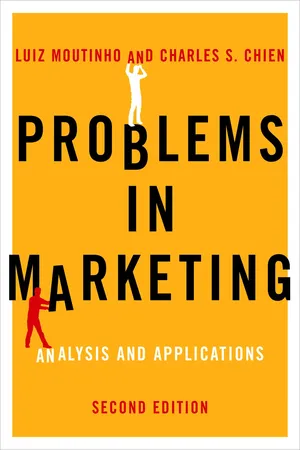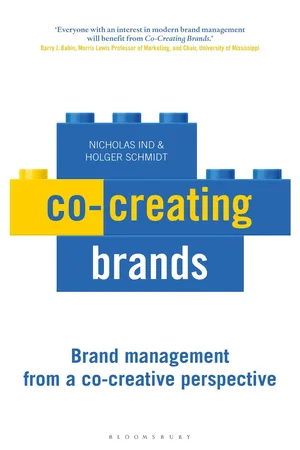Marketing
Brand positioning
Brand positioning refers to the place a brand occupies in the minds of its target audience relative to its competitors. It involves creating a unique and favorable perception of the brand in the consumer's mind. Effective brand positioning helps differentiate the brand, communicate its value, and establish a competitive advantage in the market.
Written by Perlego with AI-assistance
Related key terms
1 of 5
11 Key excerpts on "Brand positioning"
- eBook - PDF
- Steven Pike(Author)
- 2018(Publication Date)
- Goodfellow Publishers(Publisher)
A consumer can easily switch Tourism Marketing for Small Businesses 112 preferences for one brand over another, either on the basis of perceived risk, or a better value deal, and perceive they will still enjoy the features and benefits desired. Remember also, the difficulty in patenting a tourism service means that novel ideas can be quickly imitated. Hence, two of the core aims of branding are to reduce the level of perceived risk for consumers, and reduce potential product switching for the organisation (brand loyalty). Brand positioning Brand positioning represents the attempt to achieve congruence between the image aspired to in the brand identity and the actual perceptions held in the market (brand image). An effective position is one that successfully differentiates the brand in the minds of target consumers, on the basis of features and/or benefits that determine their purchase intent. On this basis, Brand positioning is recognised as being mutually beneficial for both the organisation and the consumer. From the supply perspective, effective positioning helps the brand to stand out in markets crowded with the noise of competitors offering similar features and benefits, and is therefore a source of competitive edge. From the demand perspective, effec-tive positioning simplifies decision making for the consumer, by catering to their needs and reducing the level of information searching and purchase risk. The brand position is the part of the brand identity to be actively communicated to the target market, through a focused value proposition that is meaningful to the consumer and differentiates the organisation from competitors. As discussed in 4: Tourism Marketing Planning , the marketing strategy aims to maximise strengths to take advantage of opportunities. A competitive edge is gained when consumers perceive a performance capability gap (strength), the organisation has over competitors, which will endure over time. - eBook - PDF
- O. C. Ferrell, Michael Hartline, (Authors)
- 2018(Publication Date)
- Cengage Learning EMEA(Publisher)
9 212 Chapter 7 • Branding and Positioning Copyright 2017 Cengage Learning. All Rights Reserved. May not be copied, scanned, or duplicated, in whole or in part. Due to electronic rights, some third party content may be suppressed from the eBook and/or eChapter(s). Editorial review has deemed that any suppressed content does not materially affect the overall learning experience. Cengage Learning reserves the right to remove additional content at any time if subsequent rights restrictions require it. DIFFERENTIATION AND POSITIONING Though we have focused solely on branding issues to this point in the chapter, it is vital to remember that branding is intricately tied to differentiation and positioning within the marketing program. People sometimes confuse differentiation and posi- tioning with market segmentation and target marketing. Differentiation involves creat- ing differences in the firm’s product offering that set it apart from competing offerings. Differentiation typically has its basis in distinct product features, addi- tional services, or other characteristics. Positioning refers to creating a mental image of the product offering and its differentiating features in the minds of the target mar- ket. This mental image can be based on real or perceived differences among compet- ing offerings. Whereas differentiation is about the product and the marketing program, positioning is about customers’ perceptions of the real or perceived bene- fits that the offering possesses. Although differentiation and positioning can be based on actual product features or characteristics, the principal task for the firm is to develop and maintain a relative position for the product in the minds of the target market. The process of creating a favorable relative position involves several steps: 1. Identify the needs, wants, and preferences desired by the target market. 2. Evaluate the differentiation and positioning of current and potential competitors. - eBook - PDF
Problems in Marketing
Applying Key Concepts and Techniques
- Luiz Moutinho, Charles S Chien(Authors)
- 2007(Publication Date)
- SAGE Publications Ltd(Publisher)
5 Positioning, Product and Pricing Product strategies specify market needs that may be served by different product offerings. It is a company’s product strategies, duly related to market strategies, that eventually come to dominate both overall strategy and the spirit of the company. Product strategies deal with such matters as number and diversity of products, product innovations, product scope and product design. The implementation of product strategies requires cooperation among different groups: finance, research and development, the corporate staff, and marketing. This level of integration makes product strategies difficult to develop and implement. In many companies, to achieve proper coordination among diverse business units, product strategy decisions are made by top management. In some companies, the overall scope of product strategy is laid out at the corporate level, whereas actual design is left to business units. These companies contend that this alternative is more desirable than other arrangements because it is difficult for top management to deal with the details of product strategy in a diverse company. Each strategy is examined from the point of view of an SBU. The term positioning refers to placing a brand in that part of the market where it will receive a favourable reception compared with competing products. Because the market is heterogeneous, one brand cannot make an impact on the entire market. As a matter of strategy, therefore, a product should be positioned so that it stands apart from competing brands. Positioning tells what the product stands for, what it is, and how customers should evaluate it. Positioning is achieved by using marketing mix variables, especially design and communication. Although differentiation through positioning is more visible in consumer goods, it is equally true of industrial goods. - eBook - PDF
Co-creating Brands
Brand Management from A Co-creative Perspective
- Nicholas Ind, Holger J. Schmidt(Authors)
- 2019(Publication Date)
- Bloomsbury Business(Publisher)
Some of the 167 Defining and adjusting brand strategy models are concrete and some more abstract, but they are widely used by practitioners. A brand’s positioning is based on its identity, but also follows a more tactical approach. A positioning aims to provide continuity of brand experience, adapted to various target groups throughout all brand touch points. It is the art of brand management to meet the need for consistency and, at the same time, continuous change. Learning Objectives After reading this chapter you should • understand which elements must be considered when defining a brand’s strategy; • realise that to take full advantage of co-creative brand management, managers need a clear idea of what their brand stands for; • know what the term brand identity means and be aware of the difference between a brand’s identity and its positioning; • be able to specify a brand’s identity in a practical way; • understand the important requirements in Brand positioning and know selected elements of a positioning strategy; • be aware of the difficulties in managing a brand consistently while adapting to change. Brand Strategy Imagine a warm and sunny day. You are hiking in the Alps. You didn’t take a map, the power of your iPhone is low, and your goal is to reach a mountain shelter on the other side of the valley by dawn. You can already see the hostel, which is still quite far away, but there is no road that can lead you directly towards it. You’re going to have to walk across the landscape. In this situation, you probably will take some basic decisions and make a plan, such as which direction to go in, the mountain path to follow and where to cross the river. You cannot be sure about the best and shortest way, but even if you 168 Co-creating Brands have some doubts you have to use the information available to you and set off towards your destination. - eBook - PDF
Principles of Marketing
A Value-Based Approach
- Ayantunji Gbadamosi, Ian Bathgate, Sonny Nwankwo(Authors)
- 2013(Publication Date)
- Bloomsbury Academic(Publisher)
For example, implementing an undifferentiated approach when your competitors are using a differentiated approach might be disastrous. Also, given the existence of competi-tion, an organization can identify the segments where the competition is strong and then consider whether to compete in the same segment or to find another segment that would be more favourable to it (Brassington and Pettitt, 2006). Positioning the product offering Having divided the market into smaller groups and determined the size and potential of each ( segmentation ), and having also chosen particular target markets ( targeting ), the third and last stage of the STP process should then position a product offering in the target market(s). This is known as positioning. Lancaster et al. (2002) define positioning as ‘the act of designing a company’s product and marketing mix to fit a given place in the mind of the consumer’. Positioning deals with all the activities undertaken by an organization to create and maintain in the minds of customers the concept of value about its product compared with competitors’ products. It enables businesses to distinguish their products in the minds of their customers. According to Ries and Trout (2001), positioning is not about what you do to a product, but about what you do to the mind of a prospect. It concerns the perception that a prod-uct produces in the mind of customers when compared with competitors’ products and even with other products from the same organization. Perception varies from person to person. For instance, what you perceive as quite expensive might be easily affordable to someone from a richer background or who earns much more than you do. Also, what you perceive as fashionable will be different from your mother’s perception or that of a friend of yours. However, it is important to note that there might be similarities in perception among different people. Think and discuss Pick a particular market targeting strategy. - eBook - PDF
- Dawn Iacobucci(Author)
- 2021(Publication Date)
- Cengage Learning EMEA(Publisher)
67 Positioning 5.1 What Is Positioning and Why Is It Probably the Most Important Aspect of Marketing? We know how important it is to segment the market and decide on a target; we’ve seen the S and T in STP. 1 In this chapter, we turn to positioning. Positioning has many physical elements, but even more perceptual ones. It’s about iden-tity: who your brand or company is in the marketplace vis-à-vis the competition and in the eyes of the customer. Once you see who you are, you can determine who you want to be. Positioning comprises much of a marketer’s responsibilities. It requires: ● ● Designing a product with benefits that the target segment will value. How do you want your customers to think about your brand? ● ● Pricing your product so it’s profitable yet seen as valuable. How high a price can you command for your brand? ● ● Building distributor relationships to make the market offering available. Where do customers go to find your brand? ● ● Communicating all of this to the customer through an array of promotional activi-ties—what do you say about your brand? 5 Learning Objectives After you have finished this chapter, you should be able to: LO 5-1 Describe what marketing positioning is and how a perceptual map helps LO 5-2 Explain where your brand would be in the positioning matrix and how the 4Ps of the matrix need to be consistent 5Cs Customer Company Context Collaborators Competitors STP Segmentation Targeting Positioning 4Ps Product Price Place Promotion M anagerial Checklist • Positioning via perceptual maps • The positioning matrix • Write a positioning statement Copyright 2022 Cengage Learning. All Rights Reserved. May not be copied, scanned, or duplicated, in whole or in part. Due to electronic rights, some third party content may be suppressed from the eBook and/or eChapter(s). Editorial review has deemed that any suppressed content does not materially affect the overall learning experience. - eBook - PDF
- O. C. Ferrell, Michael Hartline, O. C. Ferrell, Michael Hartline, Bryan Hochstein(Authors)
- 2021(Publication Date)
- Cengage Learning EMEA(Publisher)
Though sales have improved, there is still a long road ahead for Mattel to top its record sales of $1.2 billion in 2012. Thus, Mattel is an example of how brands must adapt and change to their environment, if they desire to retain strong brand loyalty and equity across time. BEYOND THE PAGES 7.2 7.3 DIFFERENTIATION AND POSITIONING Though we have focused solely on branding issues to this point in the chapter, it is vital to re- member that branding is intricately tied to differentiation and positioning within the marketing program. People sometimes confuse differentiation and positioning with market segmentation and target marketing. Differentiation involves creating differences in the firm’s product offering that set it apart from competing offerings. Differentiation typically has its basis in distinct prod- uct features, additional services, or other characteristics. Positioning refers to creating a mental Copyright 2022 Cengage Learning. All Rights Reserved. May not be copied, scanned, or duplicated, in whole or in part. Due to electronic rights, some third party content may be suppressed from the eBook and/or eChapter(s). Editorial review has deemed that any suppressed content does not materially affect the overall learning experience. Cengage Learning reserves the right to remove additional content at any time if subsequent rights restrictions require it. Chapter 7: Branding and Positioning 197 image of the product offering and its differentiating features in the minds of the target market. This mental image can be based on real or perceived differences among competing offerings. Whereas differentiation is about the product and the marketing program, positioning is about customers’ perceptions of the real or perceived benefits that the offering possesses. - eBook - PDF
Principles of Integrated Marketing Communications
An Evidence-based Approach
- Lawrence Ang(Author)
- 2021(Publication Date)
- Cambridge University Press(Publisher)
Rel. Know.Esteem Diff. Rel. Know.Esteem Diff. Rel. Know.Esteem Diff. Rel. Brand strength (Differentiation and relevance) Brand stature (Knowledge and esteem) Low High High Figure 3.21 The BrandAsset Valuator® Power Grid 98 Principles of Integrated Marketing Communications MANAGERIAL APPLICATION: PUTTING IT TOGETHER Very often we hear the phrase ‘we have to build the brand’. But what does this phrase actually mean? And how does this relate to Brand positioning and brand equity? To understand this, we first need to ask what exactly is a brand? Basic marketing text will suggest that a brand is a ‘name, term, sign symbol (or a combination of these) that identifies the maker or seller of the product’. 92 But such a definition, while important, is limited because a brand (e.g. Qantas) goes beyond serving the purpose of identification. It must be able to conjure up desirable thoughts and feelings in our mind (e.g. a safe way to fly) that are powerful enough to win our vote (i.e. preference). Therefore, from a marcoms perspective, it is better to think of a brand as an imprint which conjures up a network of mental associations – ideas, memories and feelings – whenever the brand is identified. Branding then is the process of creating, strengthening and maintaining those associations to the brand so that this knowledge can be easily triggered when we think of the brand. Positioning, on the other hand, is to ensure that those associations will make the brand competitive, and hence increase people’s preference for it. Over time, that preference is translated to real value, where people are even willing to pay more for it. A brand’s equity, therefore, lies in the power of the formed associations being unique and meaningfully relevant (i.e. desirable), 93 which can predispose consumers to choose it continuously over other brands. - eBook - PDF
- Daniel Padgett, Andrew Loos(Authors)
- 2023(Publication Date)
- Wiley(Publisher)
117 CHAPTER 6 Using Segmentation, Targeting, and Positioning to Distinguish a Brand Within the Market CHAPTER OUTLINE LEARNING OBJECTIVES When you finish this chapter, you should be able to: 6.1 Segmentation Market Segmentation Definition and Purpose Segmentation Variables 6.1 Define market segmentation and describe the four common categories of variables for segmenting a market. 6.2 Applied Segmentation The Segmentation Process Criteria for Effective Market Segmentation 6.2 List and describe the six steps in the market segmentation process and describe the key criteria for effectively segmenting a market. 6.3 Using Segmentation as a Foundation for Marketing Strategy Targeting Positioning 6.3 Define targeting and positioning and describe the purpose and process of each for developing marketing strategy. Introduction “People don’t hate advertising. They hate bad advertising.” When he made this statement, Pat Pellegrini was not just trying for a memorable quote. The point he makes is critical to market- ing success and has been echoed by most every successful marketer over the last 50 years. Peo- ple are busy. They are bombarded with marketing messages each day, and they only want to see and hear what is important to them. Given that there are relatively few truly new products, and given increasing competition, marketers have to differentiate their offerings by accurately understanding and appealing to a more specific group of customers. While most marketers would agree that identifying meaningful groups of customers and differentiating your offering is critical to success, how to do this effectively is not obvious. Pellegrini, however, provides some clues to this process. First, he explained that the key to getting important messages to the right person is actually knowing what the person wants, not just at the surface level, but from a deep understanding of what interests and motivates customers, and what influences their behavior. - eBook - PDF
- Rodoula H. Tsiotsou, Ronald E. Goldsmith, Rodoula H. Tsiotsou, Ronald E. Goldsmith(Authors)
- 2012(Publication Date)
- Emerald Group Publishing Limited(Publisher)
For instance, Freire (2009) reveals that the perceived degree of friendliness in local peoples’ attitudes is a crucial element in destination evaluation. Furthermore, Freire (2009) contends that many of the perceived characteristics that make local people friendly — and therefore a positive and reinforcing factor of a successful place brand — are not necessarily culturally embedded. Rather, they are taught as part of an effective tourism service delivery process, which leads to the conclusion that local people can be considered a manageable asset within place branding. Nevertheless, in practice as well as in theory, the definitions and concepts of place marketing and place branding often lack a consistent usage. As a result, place marketing is often mistakenly understood as ‘place selling’ (for a more thorough discussion, see Berglund & Olsson, 2010 ), concentrating solely on the promotional aspects while disregarding the more general objectives and range of place marketing and branding. Although the original aim of marketing is to understand and satisfy the consumer’s needs (demand orientation), place selling is more concerned with trying to find the right consumers for an existing product (supply orientation). While the two may work in conjunction, they cannot be used interchangeably. In general, place marketing is ‘the coordinated use of marketing tools supported by a shared customer-oriented philosophy, for creating, communicating, delivering, 64 Sebastian Zenker and Suzanne C. Beckmann and exchanging urban offerings that have value for the city’s customers and the city’s community at large’ ( Braun, 2008, p. 43 ). Place marketing is thus a customer-oriented approach, which aims at integrating all the existing and potential ‘customers’ of a given place. It therefore includes the concept of destination marketing, which is concerned exclusively with external target groups and their attraction to a place. - eBook - PDF
How to Brand Nations, Cities and Destinations
A Planning Book for Place Branding
- T. Moilanen, S. Rainisto(Authors)
- 2008(Publication Date)
- Palgrave Macmillan(Publisher)
Chapter 3 continues by exploring place branding practices in the context of cities and tourism destinations, and concludes with key success factors of place branding in these settings. The fourth chapter presents a description of the action plan for building a place brand for a country and for a tourism destination. The action plan identifies the different steps of building a place brand and its programming. The framework for the action plan is based on previous scientific research and an understanding of the cornerstones of success gained from practical experience. Either of the two action plans may be utilized in the context of cities, depending on their size and type. WHAT IS A BRAND? A brand is an impression perceived in a client’s mind of a product or a ser- vice. It is the sum of all tangible and intangible elements, which makes the selection unique. A brand is not only a symbol that separates one product from others, but it is all the attributes that come to the consumer’s mind when he or she thinks about the brand. Such attributes are the tangible, intangible, psycho- logical and sociological features related to the product (Kapferer 1997). The brand is a personality the customer relates to concerning the product. A brand is a promise of something. 6 How to Brand Nations, Cities and Destinations A brand is created and shaped in the consumer’s mind. A brand exists when enough people belonging to the target group think the same way about the brand’s personality. So it is not created on the designer’s table or in the office of the management group but in the customer’s mind. There are three essential concepts, also referred to in this report, that are related to brands: identity; image; and communication. The identity of the brand is defined by the sender itself, whereas a brand image is the real image developed in the receiver’s mind. Brand identity means how the owner of the brand wants it to be experienced.
Index pages curate the most relevant extracts from our library of academic textbooks. They’ve been created using an in-house natural language model (NLM), each adding context and meaning to key research topics.










